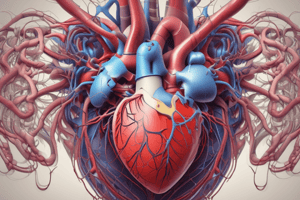Podcast
Questions and Answers
What is the primary function of the heart?
What is the primary function of the heart?
- To store oxygen for the body
- To serve as the seat of our soul
- To pump blood through the circulatory system (correct)
- To connect with our emotions
Which chambers of the heart are primarily responsible for receiving blood?
Which chambers of the heart are primarily responsible for receiving blood?
- Right atrium and left atrium (correct)
- Right atrium and left ventricle
- Right ventricle and left ventricle
- Left atrium and right atrium
How many one-way valves are present in the heart?
How many one-way valves are present in the heart?
- Two
- Four (correct)
- Five
- Three
Which valve is located between the right atrium and the right ventricle?
Which valve is located between the right atrium and the right ventricle?
What percentage of blood flowing through the atrioventricular valves moves passively?
What percentage of blood flowing through the atrioventricular valves moves passively?
What distinguishes the bicuspid valve from the tricuspid valve?
What distinguishes the bicuspid valve from the tricuspid valve?
What are the two one-way valves the ventricles push blood through called?
What are the two one-way valves the ventricles push blood through called?
Which statement is true regarding the functionality of the heart's chambers?
Which statement is true regarding the functionality of the heart's chambers?
What cultural belief attributed the housing of the soul to a different organ rather than the heart?
What cultural belief attributed the housing of the soul to a different organ rather than the heart?
What is the role of the heart valves?
What is the role of the heart valves?
Which layer of the heart is responsible for contractions?
Which layer of the heart is responsible for contractions?
What type of muscle contraction occurs during ventricular systole?
What type of muscle contraction occurs during ventricular systole?
Which nodes are part of the cardiac conduction system?
Which nodes are part of the cardiac conduction system?
What is a syncytium in the context of the heart?
What is a syncytium in the context of the heart?
Flashcards are hidden until you start studying
Study Notes
Heart Chambers
- The human heart has four chambers.
- Other mammals, birds, reptiles, amphibians, and fishes have different numbers of chambers.
- Human heart has two atria (right atrium, left atrium) and two ventricles (right ventricle, left ventricle).
- The right-side of the heart is considered weaker than the left-side.
Heart Functionality
- The heart's two pumps work in unison and are synchronized.
- The heart has four one-way valves to prevent backflow of blood as the heart fills and empties.
Heart Valves
- Tricuspid valve is between the right atrium and right ventricle.
- Bicuspid valve is located between the left atrium and left ventricle.
- These two valves are collectively known as atrioventricular valves (AV valves).
- Pulmonary valve is at the boundary between the right ventricle and the pulmonary trunk.
Blood Flow Through Valves
- Blood flow through AV valves: 70% is passive, the final 30% is pushed by the atrial wall contraction.
Heart Valves
- Heart valves are passive structures, meaning they open and close based on blood pressure differences.
- Their primary function is to prevent the backflow of blood.
- Approximately 70% of blood flow occurs during diastole (heart relaxation).
- Semilunar valves are a type of heart valve with three cusps.
Heart Wall Layers
- The heart wall consists of three distinct layers: the epicardium, myocardium, and endocardium.
- Epicardium (Outer Layer): Also known as the visceral pericardium, it's composed of mesothelial cells and connective tissue.
- Myocardium (Middle Layer): The thickest layer, made up of cardiac muscle responsible for heart contractions.
- Endocardium (Inner Layer): Composed of squamous epithelial cells, it lines the heart's chambers and blood vessels.
Cardiac Cycle
- The cardiac cycle refers to the rhythmic sequence of heart contractions and relaxations, divided into three phases:
- Atrial Diastole: Relaxation of the atrial muscle fibers.
- Atrial Systole: Contraction of the atrial myocardium, pushing blood into the ventricles.
- Ventricular Systole: Contraction of the ventricular myocardium, ejecting blood into the aorta and pulmonary artery.
Syncytium
- A syncytium is a group of cells that function as a single unit, exhibiting coordinated behavior.
- In the heart, there are two distinct syncytia:
- Atrial syncytium: Coordinated contraction of the atrial muscle.
- Ventricular syncytium: Coordinated contraction of the ventricular muscle.
Cardiac Conduction System
- The cardiac conduction system is a specialized network of nodes and fibers, modifying heart muscle cells.
- It regulates heartbeat and ensures the coordinated function of the atrial and ventricular syncytia.
- Key components of the conduction system include:
- SA Node (Sinoatrial Node): Primary pacemaker of the heart, initiating the electrical impulse.
- AV Node (Atrioventricular Node): Delays the impulse to allow ventricular filling.
- Purkinje Fibers: Rapidly transmit the impulse throughout the ventricles, initiating contraction.
Additional Notes
- The heart possesses inherent rhythmicity, meaning it can beat independently of the nervous system.
- While autonomous, heart rhythm is still regulated by the autonomic nervous system (ANS).
Studying That Suits You
Use AI to generate personalized quizzes and flashcards to suit your learning preferences.



